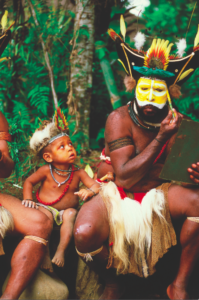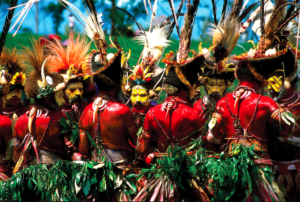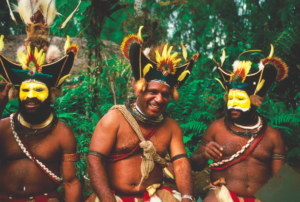The life and times of PNG’s Southern Highlands warrior clan, writes Richard Andrews
It’s a long way from the snowy village of Elora, Ontario, to PNG’s Southern Highlands – home to the Huli warrior clan.
But when Pauline Grove and her husband were looking for “a new direction” in 2004, they jumped at the opportunity to leave their Canadian restaurant and catering business and manage the Ambua eco-lodge in Tari.
“Sadly, Iain passed away during our third year, from an unexpected illness, but I felt I wasn’t finished in PNG. I stayed on to live and work with the Huli,” says Grove.

As a director of Trans Niugini Tours, Grove organises visits to local villages and has developed a strong appreciation of a unique culture that prizes art, magic and warriors.
“Huli people are very upfront,” says Grove. “If they like you, they’ll tell you; if they don’t like you, they’ll also tell you. I’ve come to respect the fact that they don’t misrepresent their intentions.”
Perhaps those traits help explain why the region’s largest ethnic group reputedly includes PNG’s “fiercest warriors”. “At the same time, villagers warmly welcome visitors and are flattered that people from around the world travel long distances to learn about the Huli way of life,” Grove says.
When European explorers first found the remote clan in the 1930s, they discovered a rich culture with colourful body decoration, dances and chants that mimic the Bird of Paradise.
To 20th-century outsiders, it was an exotic, lost world, inhabited by a people who consider themselves to be “the keepers of birds”.
“Modern visitors are still amazed by what they see and hear,” says Grove, “especially when they encounter the Huli Wigmen.”

To become a Wigman, unmarried Huli males must prepare themselves for adulthood in special schools. Ancient purification rituals and a restricted diet transform the boy into a man and make his hair grow strong and fast.
Under the guidance of a learned master, said to possess magical powers, the boy’s hair is picked out and periodically splashed with ritual water. Bands of bamboo then shape the hair into what eventually looks like a toreador’s hat.
Separated from women during this period, the boy sleeps on a headrest that prevents his hair from being squashed. After about 18 months the entire coif is clipped off close to the scalp and moulded to create the basis of the renowned Huli ceremonial wig.
“The wigs are then decorated with amazing arrays of feathers and flowers,” says Grove. “The Huli are not only warriors, but real artists as well.”
Grove also enjoys the Huli sense of humour, which is sometimes at the expense of visitors. “For example, Habia, our long-time cook at the lodge, always feigned amazement when we came to the kitchen and told him there was a vegetarian in the group,” says Grove. “He would shake his head and say ‘white man can have meat every day and they choose not to have it … tsk tsk’.”

“His astonishment is understandable when you live here. Vegetarianism is a mystifying choice to someone whose diet is mainly sweet potato, and protein is hard to come by. Pig meat on the menu is reserved for special events.”
That’s because pigs represent wealth and are the traditional exchange commodity, often used to pay for bride price, land, death indemnities and other expenses.
Despite the influence of the 21st century, Grove believes the basic Huli principles and beliefs remain intact. “It’s refreshing to see young children participating in sing-sings and village demonstrations,” she says.
“It tells me that the presence of visitors has, in fact, helped to sustain Huli culture.
“Nevertheless, there are signs of change. Western-style clothing is becoming more common and traditional dress is increasingly reserved for special occasions. The recent introduction of the mobile phone has changed communication and you hear less yodelling across the mountains.”
Grove says local guides at each lodge accompany Trans Niugini Tours visitors to villages, explaining the culture of the Huli and translating conversations. “Each village will demonstrate some aspect of their culture whether it’s a sing-sing, marriage ceremony, or a wig school,” she says.
“Visitors come from many countries,especially the US,” says Grove. “They’re typically between 50 and 80 years old, well-educated and well- travelled. But they often say meeting the Huli beats anything they’ve seen before.”

